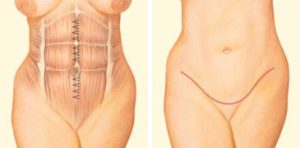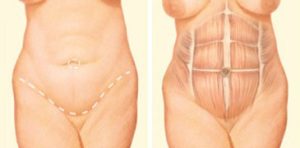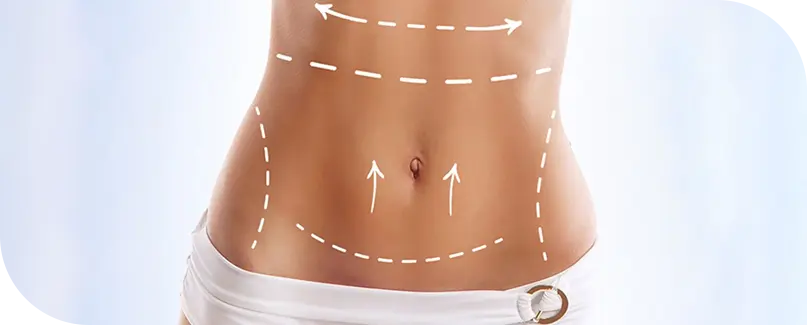Tummy Tuck (Abdominoplasty) Surgery in Turkey
A tummy tuck, also known as abdominoplasty, remains a top cosmetic surgery option in 2024, particularly in Turkey. Tummy Tuck in Turkey ranks among the top five procedures performed, as noted by the American Society of Plastic Surgeons.
What is a Tummy Tuck?
A tummy tuck is a surgical operation designed to improve the appearance of the abdomen by firming, smoothing, and contouring it. This procedure removes excess skin and tightens the abdominal wall muscles. Common causes of loose or sagging abdominal skin include aging, genetics, pregnancy, prior surgeries, and significant weight fluctuations.
Benefits of a Tummy Tuck
Patients who undergo a tummy tuck in Turkey often experience several benefits, such as:
- A more contoured waistline and firmer abdomen.
- Increased confidence in wearing new clothes.
- Reduction or removal of stretch marks.
Steps Involved in a Tummy Tuck Procedure
Step 1 – Anesthesia
To ensure comfort throughout the surgery, medications are administered. Options include intravenous sedation and general anesthesia. Your surgeon in Turkey will recommend the most suitable choice for you.
Step 2 – Incision

In a complete tummy tuck, the surgeon makes a horizontal incision between the pubic hairline and the belly button. The amount of excess skin present determines the shape and length of this incision. After lifting the abdominal skin, the surgeon repairs the underlying weakened muscles.
In some cases, the surgeon may need to make a second incision around the navel to address excess skin in the upper abdomen.

The surgeon then pulls the skin from the upper abdomen downwards, similar to lowering a window shade. They trim the excess skin and stitch the remaining skin together. The surgeon creates a new opening for the belly button, repositions it, and stitches it in place.

Step 3 – Closing the Incisions
The incisions are closed using sutures, skin adhesives, tapes, or clips.
Why Are There Different Types of Tummy Tuck?
Each patient has unique aesthetic goals and concerns regarding scarring and achieving a natural appearance. Surgeons in Turkey recommend specific tummy tuck types based on the amount of excess skin to be removed. The required incision’s location and length depend on the skin removal needed. For example, an extended tummy tuck requires a larger incision than a mini tummy tuck.
Types of Tummy Tuck Procedures

Full Tummy Tuck
so A full tummy tuck addresses both the upper and lower abdomen, making it ideal for individuals with weakened abdominal muscles or excess skin around the midsection. The procedure typically involves:
- Making a small umbilical incision for an “innie” belly button.
- Placing a short, low waistline incision hidden by underwear or swimwear.
- Removing excess skin and tightening abdominal muscles.
Recovery times vary, but patients usually need drainage tubes for a few days and can resume most activities within three weeks.
Mini Tummy Tuck
The mini tummy tuck focuses on the lower abdomen, particularly below the belly button. This procedure is suitable for patients close to their ideal weight who have stubborn fat and loose skin in this area. It involves:
- A small horizontal incision between the hipbones.
- Removing excess skin and tightening underlying muscles.
Patients typically heal within two weeks, though strenuous activities should be avoided for at least six weeks.
Extended Tummy Tuck
An extended tummy tuck includes a full tummy tuck with additional contouring of the flanks. It benefits those with significant weight loss who have excess skin and muscle laxity. The procedure may involve liposuction for optimal body contouring. Recovery time is similar to a full tummy tuck, though the scar may take longer to heal.
Fleur-De-Lis Tummy Tuck
The fleur-de-lis tummy tuck is named for its incision shape, which resembles the petals of a fleur-de-lis. This procedure is suitable for patients with excess skin in the midline abdomen, often following dramatic weight loss. It involves:
- A horizontal incision along the pubic bone.
- A vertical incision along the abdomen’s midline for tightening.
Recovery includes a two to three-week period before returning to work, with exercise resuming after six weeks.
Drainless Tummy Tuck
Some tummy tucks are performed without drains using a progressive suture technique. This method involves “quilting” the abdominal skin to underlying tissues, reducing fluid buildup. Patients typically wear compression garments during recovery, which is generally quicker than with traditional tummy tucks.
Tummy Tuck with Liposuction
Combining a tummy tuck with liposuction can effectively remove excess skin and fat, providing enhanced contouring. This combination may involve multiple treatment areas and requires careful planning with a board-certified surgeon in Turkey.
Making an Informed Decision
For those considering a tummy tuck in Turkey, consultation with a board-certified plastic surgeon is essential to gather information and make an informed decision. Understanding the benefits, risks, and recovery processes associated with each type of tummy tuck will help patients choose the best option for their needs.
Reasons for a Tummy Tuck
Excess fat, reduced skin elasticity, and weakened connective tissue in the abdomen can be caused by:
- Significant weight fluctuations
- Pregnancy
- Abdominal surgeries, such as C-sections
- Aging
- Natural body type
A tummy tuck, or abdominoplasty, can help by removing loose skin and fat and tightening weakened fascia. This procedure can also eliminate stretch marks and excess skin below the bellybutton, although it doesn’t address stretch marks outside this area. If you have a previous C-section scar, your surgeon might incorporate it into the new scar line. Additionally, a tummy tuck can be combined with other cosmetic procedures, such as breast surgery. If you’ve had liposuction to remove abdominal fat, you might consider a tummy tuck to remove excess skin.
Considerations Before a Tummy Tuck
Not everyone is a good candidate for a tummy tuck. Your doctor in Turkey may advise against the procedure if you:
- Plan to lose a significant amount of weight
- Might become pregnant in the future
- Have serious chronic conditions like heart disease or diabetes
- Have a BMI over 30
- Smoke
- Have had prior abdominal surgeries with significant scarring
Preparing for Surgery
During your consultation in Turkey, your plastic surgeon will likely:
- Review your medical history: Be ready to discuss your current and past medical conditions and any medications you’re taking.
- Conduct a physical exam: The surgeon will examine your abdomen and possibly take photos for your medical records.
- Discuss your expectations: Explain your goals and understand the procedure’s benefits and risks, including potential scarring.
During the Procedure
The surgeon will make incisions to remove excess skin and fat, usually between the bellybutton and pubic hair. The connective tissue is tightened with sutures, and skin around the bellybutton is repositioned. The procedure generally takes 2-3 hours.
Recovery Process
What to Expect After a Tummy Tuck (Abdominoplasty)
Recovery from a tummy tuck (Abdominoplasty) is generally faster than a full tummy tuck due to the less invasive nature of the procedure. You can expect mild to moderate swelling, bruising, and discomfort during the first week. Most patients can return to light activities within 1–2 weeks, though full recovery may take up to 4–6 weeks. Wearing a compression garment for the first few weeks helps reduce swelling and supports the healing tissues. Your surgeon will provide specific instructions for managing discomfort and ensuring optimal healing.
Resuming Physical Activities After Surgery
While light activities, such as walking, can be resumed within a few days, strenuous activities like heavy lifting and intense workouts should be avoided for at least 4–6 weeks. Your surgeon will advise you on when it is safe to return to sports and exercise, with a particular focus on avoiding strain on the abdominal muscles during the recovery period.
Maintaining the Results of a Tummy Tuck (Abdominoplasty)
The results of a tummy tuck are long-lasting, provided you maintain a stable weight. A healthy diet and regular exercise are key to preserving your flatter, more toned abdomen. Significant weight fluctuations could affect the outcome of the procedure, so maintaining a consistent weight is crucial for long-term success.
Scarring After a Tummy Tuck (Abdominoplasty)
The incision for a tummy tuck is smaller than that of a full tummy tuck and is usually located just above the pubic area, making it easily concealed under clothing. With proper care, including scar treatments and avoiding sun exposure, the scar will fade over time. Your surgeon will provide detailed instructions on how to care for the incision to ensure the best healing and minimal scarring.
Understanding the Risks of a Tummy Tuck (Abdominoplasty)
While a tummy tuck is considered a safe procedure, there are some risks involved, including infection, bleeding, poor wound healing, or asymmetry. Choosing an experienced surgeon, such as those at ClinMedica, minimizes these risks. Following all post-surgery care instructions and attending follow-up appointments will further reduce the likelihood of complications and ensure a
Risks Involved
Tummy tucks involve various risks; therefore, it is important to understand these potential complications. Some of these risks include:
- Fluid accumulation (seroma): Drainage tubes may be used post-surgery to reduce fluid buildup. Additionally, your doctor might remove excess fluid with a needle if necessary.
- Poor wound healing: Some areas along the incision may heal poorly. As a result, you may need antibiotics to prevent infection.
- Unexpected scarring: The scar is permanent but usually located along the bikini line. However, the scar’s length and visibility vary between individuals.
- Tissue damage: Fatty tissue deep within the abdomen could be damaged, especially in smokers. This may, in turn, require additional surgery.
- Changes in sensation: The repositioning of tissues may affect nerves, leading to temporary numbness, particularly in the upper thighs.
As with any major surgery, a tummy tuck carries risks of bleeding, infection, and adverse reactions to anesthesia.
Benefits of a Tummy Tuck (Abdominoplasty) in Turkey
The benefits of a tummy tuck include a flatter, more contoured abdomen with a shorter recovery time compared to a full tummy tuck. It is an excellent option for individuals with mild to moderate skin laxity or excess fat in the lower abdomen. Patients often report increased confidence and satisfaction with their improved silhouette.
Who Is Not a Suitable Candidate for a Tummy Tuck?
Not all individuals are suitable candidates for a tummy tuck. Patients with significant skin laxity, those with a higher body weight, or those with certain medical conditions, such as uncontrolled diabetes, may not be ideal candidates. Additionally, individuals seeking more extensive abdominal correction may benefit from a full tummy tuck instead. A thorough consultation with your surgeon will help determine if this procedure is right for you.
Things to Do After a Tummy Tuck in Turkey
Key Post-Operative Care Steps
After your tummy tuck in Turkey, it’s essential to follow your surgeon’s post-operative care instructions closely. This includes wearing a compression garment to reduce swelling, keeping the incision site clean, and avoiding physical strain. Proper hydration, nutrition, and rest will support your healing process. Attending all follow-up appointments is crucial to ensure proper recovery and achieve the best results.
Things to Avoid During Recovery
To ensure a smooth recovery, avoid smoking and alcohol consumption, as they can delay the healing process and increase the risk of complications. Strenuous activities, such as heavy lifting and abdominal exercises, should be avoided for at least 4–6 weeks or until your surgeon advises it is safe to resume them. Additionally, avoid exposing the incision site to direct sunlight, as this can darken scars.
How Long Should You Stay in Istanbul for the Procedure?
If you’re traveling to Turkey for a tummy tuck (Abdominoplasty), it is recommended to stay in Istanbul for about 7–10 days. This will allow enough time for the procedure, the initial recovery phase, and follow-up appointments to ensure your healing is progressing well before you return home.
How Many Nights Will You Stay in the Hospital?
A tummy tuck (Abdominoplasty) is typically performed as an outpatient procedure, meaning you can return to your accommodation the same day. However, depending on your surgeon’s recommendations and the specifics of your surgery, you may be advised to stay one night in the hospital for observation.
Pre-Procedure Instructions for International Patients
If you’re traveling to Turkey for a tummy tuck (Abdominoplasty), preparing well in advance is essential:
- Medical Preparation: Complete all necessary medical tests and provide your surgeon with a detailed medical history, including any medications or supplements you are taking.
- Packing: Bring loose, comfortable clothing that is easy to put on and take off without causing strain on the abdominal area. Button-up or zip-up tops are recommended.
- Flexible Flight Plans: Arrange flexible flights to accommodate any changes in your recovery schedule.
- Documentation: Carry all relevant medical records, including test results and surgical clearances from your healthcare provider.
Pre-surgery preparations include:- Stop smoking: Smoking can slow healing and increase tissue damage risk.
- Avoid certain medications: Your doctor may advise stopping aspirin, anti-inflammatory drugs, and herbal supplements to reduce bleeding risks.
- Maintain a stable weight: Ideally, your weight should be stable for at least 12 months before the procedure.
- Arrange help for recovery: Plan for someone to drive you home post-surgery and stay with you the first night.
Do You Need a Companion for the Procedure?
While a companion is not mandatory for a tummy tuck, having someone with you during the first few days of recovery can be helpful. A companion can assist with daily tasks, provide emotional support, and help ensure your comfort during the initial healing period. If traveling alone, consider arranging post-surgical care at your accommodation to ensure you have the support you need.
Post-Surgery Instructions
What Should You Do After a Tummy Tuck (Abdominoplasty)?
Your surgeon will provide detailed post-surgery instructions, including wearing a compression garment, avoiding strenuous activities, and using cold compresses to reduce swelling. It’s important to follow these guidelines carefully and attend all follow-up appointments to ensure proper healing and the best possible outcome.
Traveling Home After Surgery
Guidelines for Airport and In-Flight Care
If you’re flying home after your tummy tuck (Abdominoplasty) in turkey, particularly on a long-haul flight, follow these guidelines:
- Timing Your Flight
Plan to stay in Istanbul for at least 7–10 days after surgery to allow for initial healing and follow-up care before flying home. - In-Flight Care
During the flight:
- Move Around Regularly: Walking around the cabin every 1–2 hours can help improve circulation and reduce the risk of blood clots.
- Stay Hydrated: Drink plenty of water and avoid alcohol or caffeine, as these can increase swelling.
- Wear Comfortable Clothing: Choose loose-fitting clothes and follow your surgeon’s advice regarding any compression garments.
- Pain Management: Keep prescribed pain medications and necessary care supplies in your carry-on luggage and take them as directed.
- Airport Assistance
Navigating the airport post-surgery can be tiring. Consider requesting assistance, such as a wheelchair or help with luggage, to avoid overexerting yourself. Avoid carrying heavy bags and use rolling luggage to minimize physical strain. - Long-Haul Flight Considerations
For long-distance travel, ensure you move around regularly to prevent stiffness and swelling. Plan for additional rest days after returning home to allow your body to fully recover before resuming regular activities.
By following these post-surgery and travel guidelines, you can ensure a smooth recovery and a safe journey home after your tummy tuck. ClinMedica provides comprehensive care instructions to help you achieve the best possible results.
When Will You See the Final Results?
You may notice some improvement in your abdominal contour shortly after the surgery, but the final results of a tummy tuck will take several months to fully manifest as swelling subsides and the tissues settle. The results are long-lasting, provided you maintain a stable weight and follow your surgeon’s post-operative care instructions.
Explore Tummy Tuck (Abdominoplasty) before after

